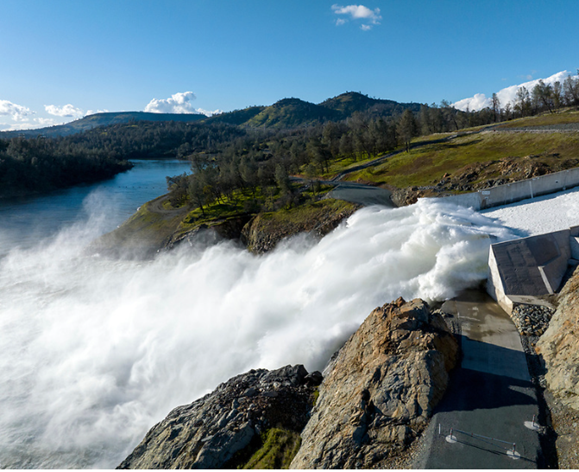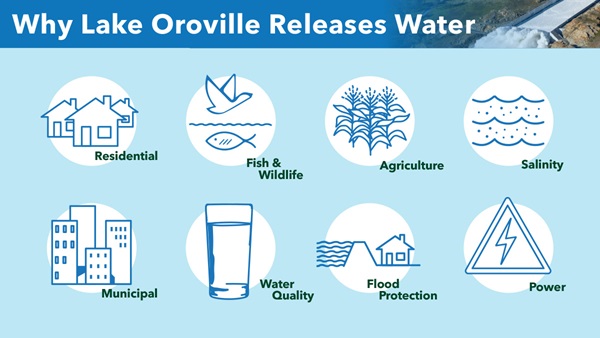State Water Project Operations Continues to Adapt to Climate Change
Flood control releases from Lake Oroville to the Feather River on March 10, 2023.
As California experiences more extreme swings between wet and dry periods, DWR continues to deploy innovative forecasting and water management strategies for the State Water Project (SWP) to adapt to California’s changing climate.
The SWP delivers an average of 2.4 million acre-feet of water to more than 27 million Californians and 750,000 acres of farmland while providing multiple benefits, such as flood control, hydropower generation, fish and wildlife protections, drinking water quality, and recreational opportunities. Releases from Lake Oroville, the largest SWP reservoir, also keep salt water from intruding into the Delta and contaminating drinking water or water used to irrigate crops.
The primary purpose of the SWP is capturing and storing as much surface water supply as possible. The SWP diverts and stores surplus water during wet periods and distributes the water to 29 SWP water contractors – all public agencies that have contracts for this water that they then distribute to farms, homes, and industry. Annual water supply deliveries depend on rainfall runoff, snowpack, existing water in storage facilities, Delta pumping capacity, and environmental regulations.
The State Water Project is required to follow more than one regulation when releasing water from SWP reservoirs, such as from Lake Oroville. Releases from Lake Oroville are to meet requirements set forth by the State Water Resources Control Board, U.S. Army Corps of Engineers, California Department of Fish and Wildlife, Federal Energy Regulatory Commission, and National Marine Fisheries Service. The SWP release decisions are also made together with the U.S. Bureau of Reclamation which operates the Central Valley Project, since many requirements must be jointly met by the two projects.
DWR continues to explore several improvements to existing SWP infrastructure that can improve water supply reliability, water quality, water temperature control, and increased electricity integration of water supply infrastructure. For example, the Delta Conveyance Project would help protect Delta water supplies from the sea level rise, help to capture more water from flood events, protect the infrastructure from earthquakes, and increase operational flexibility to protect fisheries. New facilities being explored at Oroville reservoir would allow the SWP to provide energy storage for the electric grid while continuing to protect downstream river temperatures for fish.

SWP operations were also modified in 2018, when the target for the amount of water to be left in storage in Lake Oroville at the end of September was increased by 300,000 acre-feet. This change was made to provide greater protection against more severe droughts brought about by climate change.
New technologies, like Airborne Snow Observatory observations and enhanced use of forecasting technology are helping DWR hydrologists improve water supply forecasts as climate change continues to produce extreme wet and dry periods
As a leader in modeling climate change impacts on the system operations and water supplies, DWR is constantly advancing new methods to improve water supply reliability. Through forecast informed reservoir operations, DWR is partnering with the U.S. Army Corps of Engineers, Yuba Water Agency, National Oceanic and Atmospheric Administration, and Scripps Institution of Oceanography by using scientific improvements in forecasting atmospheric rivers to better anticipate and manage large storm events while maximizing opportunities to increase water supply.
While addressing the climate change challenges of today and in the future, DWR will continue to maximize the SWP’s water storage and delivery throughout California as it has done for more than 60 years and allowed it to become one of the greatest engineering achievements of the 20th century.
For more about how DWR is addressing climate change in our programs, projects, and activities, view the Climate Action Plan.
